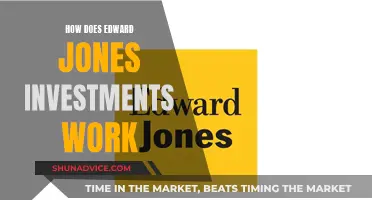
CAN SLIM is an investing strategy that identifies seven characteristics that top-performing stocks often share before making their biggest price gains. It was developed in the 1950s by William O'Neil, founder of Investor's Business Daily, and is designed to identify strong-performing growth stocks. The seven characteristics are:
- Current quarterly earnings
- Annual earnings growth
- New product, service, or management
- Supply and demand
- Leader or laggard
- Institutional sponsorship
- Market direction
| Characteristics | Values |
|---|---|
| C | Current quarterly earnings |
| A | Annual earnings growth |
| N | New product, service, or management |
| S | Supply and demand |
| L | Leader or laggard |
| I | Institutional sponsorship |
| M | Market direction |
What You'll Learn

Current quarterly earnings
The CAN SLIM investment strategy is a guide to selecting stocks with high growth potential. It was developed in the 1950s by William O'Neil, the founder of Investor's Business Daily, and outlined in his book "How to Make Money in Stocks: A Winning System In Good Times or Bad". The strategy is based on seven characteristics, represented by the acronym CAN SLIM, that top-performing stocks often share before making their biggest price gains.
The "C" in CAN SLIM stands for "Current Quarterly Earnings". This refers to the earnings per share (EPS) in the most recent financial quarter compared to the same quarter in the previous year. Investors using the CAN SLIM system typically look for EPS growth of 25% or more in the most recent quarter, although higher growth is preferable. For example, the best stocks often have EPS growth ranging from 50% to 100% or higher. It is also important to consider the reliability and sustainability of this growth. One way to do this is to look at the company's return on equity (ROE), which should ideally be 17% or higher.
In addition to strong quarterly earnings growth, CAN SLIM investors also look for high sales growth of at least 25%. This is because sales drive earnings, and a company cannot maintain earnings growth without consistent sales growth.
When analysing current quarterly earnings, it is important to be sceptical of the financial reports that companies put out. This is because businesses may have incentives to manipulate the numbers, so it is crucial to delve deeper to understand whether the reported growth is real or artificially inflated.
Overall, the "C" in CAN SLIM represents the importance of strong current quarterly earnings growth as a key indicator of a stock's potential for significant price increases in the future.
The RRSP Dilemma: Investing for the Future or Paying Off Debt?
You may want to see also

Annual earnings growth
The "A" in CAN SLIM stands for annual earnings growth, which is a crucial indicator of a company's long-term performance. O'Neil suggests that investors should look for annual earnings growth of at least 25% over the past three years. This indicates that the company has been consistently increasing its profits year after year.
Additionally, it is important to consider the annual earnings growth in conjunction with the company's return on equity (ROE). O'Neil recommends looking for companies with an ROE of 17% or higher. This metric indicates how efficiently a company is utilising its shareholders' investments to generate profits. A high ROE suggests that the company is effectively using its resources to produce earnings growth.
When analysing annual earnings growth, it is also essential to examine the company's performance over a more extended period. O'Neil suggests looking at the previous five years of earnings reports to ensure that the company has maintained its growth trajectory. While a company might have a good year or two, it is more challenging to sustain earnings growth over a more extended period.
Furthermore, the CAN SLIM strategy emphasises the importance of comparing a company's annual earnings growth to its peers and the overall market. Investors should seek out companies that consistently outperform their competitors and the major market indices, such as the S&P 500, Dow Jones averages, NASDAQ, and NYSE Composite.
By focusing on annual earnings growth, the CAN SLIM strategy helps investors identify companies with strong financial performance and the potential for sustained growth over time. This strategy encourages investing in solid companies with consistent and robust earnings growth, which is a key factor in making informed investment decisions.
In summary, the CAN SLIM investing strategy's annual earnings growth component is a critical aspect of evaluating potential investments. By considering annual earnings growth, investors can identify companies with strong financial fundamentals and the potential for long-term success.
The Evolution of Investing: Transforming the Old to Embrace the New
You may want to see also

New products or services
The CAN SLIM investment strategy is a guide to help investors identify stocks with high growth potential. The strategy was developed in the 1950s by William O'Neil, the founder of Investor's Business Daily, and outlined in his book, "How to Make Money in Stocks: A Winning System In Good Times or Bad".
The "N" in the CAN SLIM acronym stands for "new product or service". This means that, to be a worthwhile investment, a company should have a history of innovation and continuing development. This could be in the form of new products, services, or management.
A new product or service is an important indicator of a company's future success and can drive stock prices. For example, when Apple introduced the iPhone, it created excitement that drove up stock prices. Similarly, new management can also positively impact a company's performance, especially if they have innovative ideas that they actively communicate.
It is also important to consider whether a company's innovations are superior to their competitors in price and quality. For instance, a company with a history of innovation and a track record of developing products that are better and cheaper than the competition is a good sign of future stock price growth.
Therefore, when considering the minimum investment to buy slim, it is crucial to look for companies with a strong history of innovation and continuing development in products, services, or management.
Invest Wisely: Strategies for Success
You may want to see also

Supply and demand
The CAN SLIM investment strategy is a stock-picking system that identifies seven characteristics that top-performing stocks often share before making their biggest price gains. The strategy was developed in the 1950s by William O'Neil, the founder of Investor's Business Daily, and outlined in his book, "How to Make Money in Stocks: A Winning System In Good Times or Bad".
The "S" in the CAN SLIM acronym stands for "supply and demand". This criterion focuses on the demand for a stock, as measured by its trading volume, particularly during price increases. O'Neil recommends investing in stocks with a smaller number of shares outstanding, creating a higher demand and potentially leading to large gains.
When assessing supply and demand, investors should look for stocks with a high trading volume during price increases and a small float (fewer shares outstanding) relative to other companies. A stock with a high trading volume and a limited number of shares can lead to increased demand and, consequently, a rise in its price.
Additionally, investors should consider the relative price strength of the stock compared to its competitors. O'Neil suggests that a stock with a relative price strength rating of 80 or higher indicates a market leader.
By focusing on supply and demand, the CAN SLIM strategy helps investors identify stocks with the potential for significant price increases due to high demand and limited supply. This approach is particularly effective in a bullish market, where the demand for stocks is generally higher.
Monthly Cash Flow: Exploring Regular-Income Investments
You may want to see also

Leader or laggard
The L in CAN SLIM stands for 'Leader or Laggard'. This is a qualitative measurement that asks whether the company is a leader in its market.
O'Neil suggests that investors identify leaders through relative price performance. A security's 52-week relative price strength rating (RPSR) that outperforms 80% of the market is a good indication that it is a market leader.
The stock you buy should be outperforming its peers and the major indexes (S&P 500, Dow Jones averages, NASDAQ, NYSE Composite, etc.) over the last six months to a year.
A company that is a leader in its industry will have some critical competitive advantages in product, service quality, or pricing. However, it can be impossible to find these companies by analysing every firm's product listing and conducting a competitive market analysis. Therefore, O'Neil suggests looking for companies with stock price strength higher than their competitors, even above 80% of the stock market.
Essentially, any company near, at, or breaking through its stock price 52-week high is a candidate. Adding to this, a company that is outperforming the major market indices regarding price growth is also a good sign.
Mortgage Freedom or Investment Gains: Where Should Your Money Go?
You may want to see also
Frequently asked questions
There is no minimum investment required to start using the CAN SLIM strategy. However, it is important to note that this strategy is designed for seasoned investors and involves investing in high-growth stocks, which can be more volatile and risky.
While there is no definitive answer, it is generally recommended to have a substantial amount of capital to invest. This is because the strategy involves investing in high-growth stocks, which can be more expensive, and diversifying your portfolio across multiple companies to manage risk.
Yes, it is possible to use the CAN SLIM strategy with a small investment account. However, you may need to be more selective in choosing which stocks to invest in and may have a more concentrated portfolio. It is important to carefully consider your risk tolerance and financial goals before investing.
There are no specific fees or costs associated with implementing the CAN SLIM strategy itself. However, you may incur typical investment fees and brokerage commissions when buying and selling stocks. Additionally, if you choose to use a stock screener or subscription service to identify CAN SLIM stocks, there may be associated costs.







